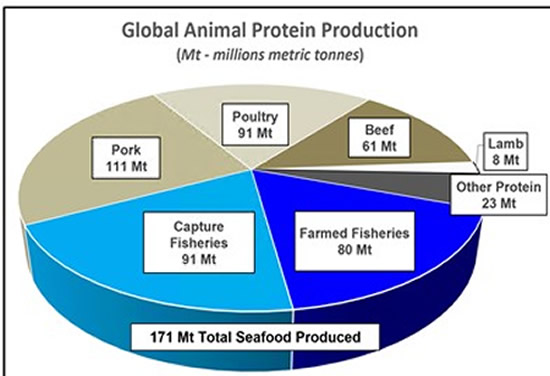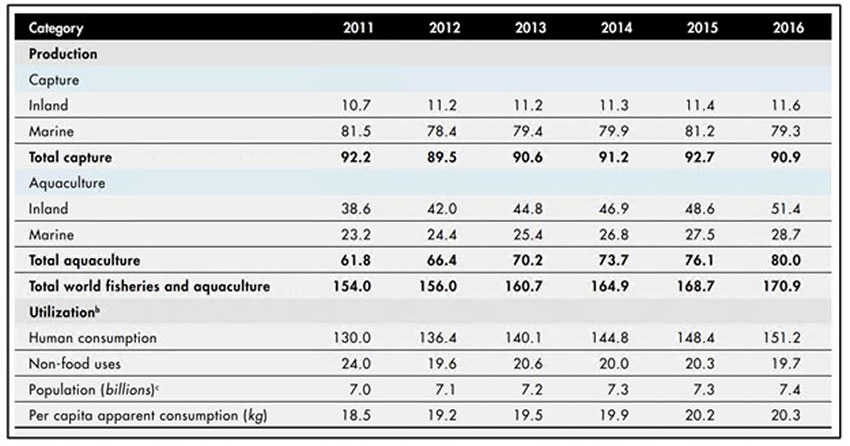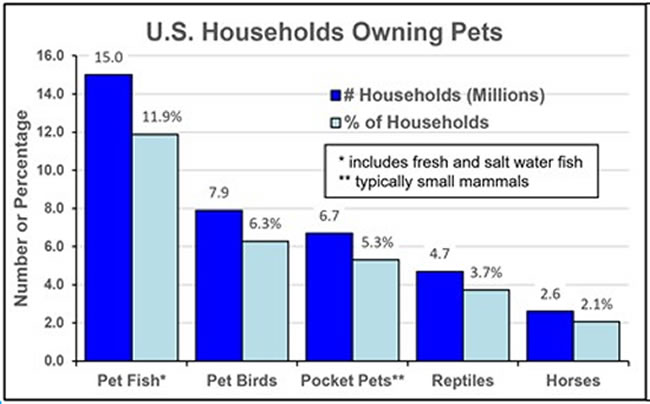International Efforts to Validate Day-1 Competency in Aquatic Veterinary Education
The global demand for well-trained aquatic veterinarians represents a huge opportunity for veterinarians willing to expand the services they offer clients. While aquatic animals (fish, amphibians, reptiles, non-agricultural birds and mammals, etc.) are frequently considered exotic or minor species, aquatic veterinary medicine is a well-defined, but poorly recognized veterinary discipline. As the fastest growing veterinary discipline globally, services to aquatic pet (ornamental) and aquaculture (farmed fisheries) represent a largely untapped opportunity for many veterinarians wanting to expand their practices. By example, globally captured and farmed seafood production is now larger than any other animal protein-producing industry (Figure 1), an industry considered by many to be one of the few industries that will feed an ever-growing human population that is expected to reach 9–10 billion by 2050 (Table 1).
| Figure 1. Current production of global animal protein-producing industries | 
Data from FAO (2018) and FishStatJ database (accessible at: www.fao.org/fishery/statistics/en). |
|
| |
Table 1. Capture fisheries is progressively declining (from overfishing), while farmed fisheries (aquaculture), considered by many to be one of the few industries able to expand to feed a growing human population, continues to grow exponentially

Data from FAO (2018); a excludes aquatic animals, reptiles, and plants; b & c estimated for 2014–2016 by the UN in 2015.
Similarly, in many countries the number of ornamental (pet) aquatic animal is growing, and frequently exceeds the number of cats or dogs owned (AVMA 2012; APPA 2017; Statista 2017). But more importantly, by example, in the USA, while 30–35% of households in the U.S. have dogs (60 million) and/or cats (47 million), more than 15 million households (12%) own pet fish, almost as many that own all other types of minor species pets, collectively (Figure 2).
| Figure 2. Number and percentage of 2017 U.S. households owning pet horses and “exotic” animal pets | 
Data from APPA 2018. Informal data suggest similar situations in other western countries (e.g., ∼3.3 million European households own similar numbers of fish and other “exotic” pets (Statista 2017 and other sources). |
|
| |
Unfortunately, increasing impacts of diseases have had enormous impacts on these industries.
Numerous efforts are underway to ensure that sufficient numbers of veterinarians are available to support aquaculture industries and producers, government agencies that support or regulate aquaculture, and a myriad of other supporting industries that provide therapeutic products, laboratory diagnostic services, and a number of other services. However, little attention has been given to ensure that veterinary school curricular provide the core (Day-1) knowledge, skills and experience (KSEs) or competency, to service the needs of ornamental (pet)-owing, or aquaculture (seafood-producing) clients. Without this infrastructure, sustainable and economically viable aquaculture will simply not thrive.
There is therefore a critical need for a well-trained aquatic veterinary workforce.1
The work presented here therefore outlines the progress on efforts to 1) identify what core competency (knowledge, skills and experience/education or KSEs) are needed for a well-trained aquatic veterinary workforce; 2) evaluate and validate that these KSEs meet the needs of this workforce in delivering services to aquaculture and ornamental aquatic animal producers and owners; and 3) determine what educational opportunities exist in veterinary school curricular, and how well they address the needs of these industries.
While efforts by several entities address aquatic veterinary education needs, that of the World Aquatic Veterinary Medical Association (WAVMA) stands out. Developed in 2010, the Aquatic Veterinary Certification (CertAqV) Program identifies the core (Day-1) knowledge, skills and experience (KSEs) needed. It also recognizes those veterinarians with sufficient KSE (obtained through a variety of educational opportunities) as competent to practice aquatic veterinary medicine. Specifically, this program identifies nine core subject-matter areas (Modules) that are directly relevant to providing aquatic veterinary services to aquaculture and/or ornamental (pet) producers and animal owners. They primarily focus on finfish, molluscan and crustacean medicine, although the principles are easily applicable to any aquatic taxa, including mammals, birds, reptiles and amphibians.
These Modules include both preclinical and clinical topics that an aquatic veterinarian needs to be familiar with, including:
Preclinical:
1. Anatomy and physiology of aquatic species/taxa
2. Environmental factors affecting aquatic animal health
3. Structure and function of aquaculture and ornamental (pet) industries
Preclinical:
4. Pathobiology and epidemiology of important aquatic animal diseases
5. Clinical and laboratory diagnostics used for diagnosing aquatic animal diseases
6. Availability and appropriate use of therapeutic and biologic agents in aquatic veterinary medicine
7. Public health, zoonotic diseases and seafood safety issues important in aquatic veterinary medicine
8. International and national legislation, regulations and policies affecting aquatic veterinary medicine
9. Principles of welfare and humane treatment of aquatic animals
Importantly, in developing the CertAqV Program it was recognized that if creative, adaptive thinking is an integral part of a veterinary curriculum, that 80–90% of the general medical principles learned during veterinary school can easily be applied to aquatic veterinary medicine.
A veterinary workforce includes veterinarians and para-veterinarians (veterinary technicians or nurses, fisheries biologists, and other research scientists who provide important and vital laboratory and other supportive services) who collectively provide the services needed to ensure the health and welfare, and implement optimal measures for the prevention, control and eradication of animal diseases. In most countries, these individuals need to be licensed or registered (DeHaven, Scarfe 2012).
While some aquatic veterinary organizations and veterinary schools are examining which of these nine Modules are covered in their educational programs or curriculum, whether these meet the needs of aquatic veterinarians in private practice has not yet been validated.
Customarily veterinarians have relied on extracurricular continuing education and professional development (CEPD) programs after graduation or postgraduate degrees, to refine or improve their knowledge, skills and experience (KSEs) to practice in any chosen field. While aquatic CEPD programs are abundant (e.g., Hartman et al. 2006), little attention has been given to discover how veterinary school curricular address aquatic veterinary medicine.
An early, small study suggested that a number of European universities (not all were at veterinary schools) offer aquatic animal health courses suitable for veterinarians (Weber et al. 2009). Two follow-up surveys, one of European veterinary schools (De Briyne 2014, personal communication & unpublished data), and another (Scarfe 2014, personal communication & unpublished data) that focused on N. American and asked questions related to the WAVMA CertAqV Program subject matter, revealed some interesting additional preliminary information: around 60% of veterinary schools in both regions included some aspects of aquatic veterinary medicine into at least one course; 50–60% of these courses were required of all students; most courses were given every year; some of these courses had been taught for >20 years; and, the majority of courses emphasized finfish (vs. other aquatic species).
While no veterinary school covered all Day-1 subjects identified by WAVMA as important to practice aquatic veterinary medicine, these studies and other information suggested that a large number of veterinarians (perhaps 5–10,000) in North America, Western Europe and perhaps Australia/New Zealand, may have sufficient KSEs to support an adequate aquatic veterinary workforce, whereas other regions need improvement. Building on this information we are in the process of evaluating and validating the KSEs needed to practice aquatic veterinary medicine, and discover what is covered in veterinary curricular throughout the world.
Most academic curricula, syllabi, and courses are developed through a top-down process, where administrators determine what they think students need. However, we have and will continue to utilize a unique bottom-up approach that involves using input from practicing full-time aquatic veterinarians to identify the key Day-1 KSEs that would be expected of new graduates. This DACUM (Developing a Curriculum) approach has proven to be very effective, relatively quick, and a low-cost approach to accurately develop occupational standards for any job, or work-related tasks. Because of its low cost and effectiveness, it has been and continues to be used by educators and trainers in over 40 countries (Adams et al. 2015), including veterinary medicine (e.g., Miller et al. 2004).
The DACUM process involves a panel of 6–12 expert workers, the men and women with reputations for being the best at their jobs. Whether at the skilled, technical, supervisory, or professional level, these workers explain exactly what they do, that allows them to be successful (Adams et al. 2015).
To evaluate the WAVMA CertAqV Modules, we used six aquatic veterinarians who are actively engaged in private aquatic veterinary medicine practice. They participated in a 3-day workshop during which they completed an occupational analysis that identified key general areas of competence (GAC equivalent to CertAqV Modules), and the essential competencies (KSEs) within each GAC, that are necessary to practice competent aquatic veterinary medicine. The resulting occupational analysis identified 18 general areas of competence and 189 individual competencies essential for the Day-1 practitioner of aquatic veterinary medicine.
Finally, to validate that these are what any aquatic veterinarian needs to practice, 3–5 additional aquatic veterinarians, from different global regions, will be used to validate that these apply to needs in the Americas, Europe, Africa and the Asia-Pacific. This approach is to ensure that significant GACs have not been omitted, weight each competency in relation to its GAC, and ensure needs of of different countries is accommodated. While still in progress, the resulting occupational analysis will serve as the basis for evaluating whether existing veterinary curricula adequately cover sufficient information, and will be useful for developing model curricula to ensure a veterinarian desiring to practice aquatic veterinary medicine has sufficient Day-1 KSEs.
As in all veterinary disciplines, most applied knowledge and skills are refined and honed in the first years of private practice, when delivering services to animal-owning clients. This is when veterinarians draw on a vast number of medical principles learned during their veterinary degree that apply to any species, and apply them to hone their knowledge and skills in dealing with species not traditionally addressed in the veterinary curriculum. This continues through life-long learning, and most countries require veterinarians to document a minimum number of hours of continuing education and professional development (CEPD), as a condition to legally practice veterinary medicine. Aquatic veterinary medicine is no exception.
With the assistance of the Council on International Veterinary Education and collaboration from other national and international veterinary organizations, we hope that efforts in 2019 and beyond will help evaluate aquatic veterinary education opportunities throughout Africa, Asia, Eastern Europe, South America, and perhaps the Middle East.
References
1. Adams RE, Hogan RL, Steinke LJ. DACUM: The Seminal Book. Wilmington, DE, USA: Edwin & Associates; 2015:372 pp.
2. APPA. 2017–2018 National Pet Owners Survey. American Pet Products Association, Inc., Stamford, CT, USA. 2017.
3. AVMA. U.S. Pet Ownership and Demographics Sourcebook. American Veterinary Medical Association, Schaumburg, IL, USA. 2012
4. Statista. Number of ornamental fish in the European Union in 2017, by country. Statistics and market data on Consumer Goods & Fast Moving Consumer Goods. Statista, Inc., New York. 2017. Accessed July 2017 from www.statista.com/statistics/515432.
5. DeHaven WR, Scarfe AD. Professional education and aquatic animal health: a focus on aquatic veterinarians and veterinary para-professionals. In: Proceedings of the OIE Global Conference on Aquatic Animal Health Programmes. Panama, 2830 June 2011. World Organisation for Animal Health (OIE), Paris. 2012:139–154.
6. FAO. The State of World Fisheries and Aquaculture 2018. Meeting the Sustainable Development Goals. Food & Agricultural Organization of the United Nations, Rome, Italy.2018:210 pp.
7. Hartman KH, Yanong RPE, Harms CA, Lewbart GA. The future of training for aquatic animal health veterinarians. J Vet Med Educ. 2006;33(3):389–393.
8. Miller RB, Hardin LE, Cowart RP, Ellersieck MR. Practitioner-defined competencies required of new veterinary graduates in food animal practice. J Vet Med Educ. 2004;31(4):347–365.
9. OIE. Tool for the Evaluation of Performance of Veterinary Services and/or Aquatic Animal Health Services (OIE PVS Tool: Aquatic). World Organization for Animal Health (OIE), Paris. 2013:70 pp.
10. Weber ES 3rd, Blanc G, Hedrick RP. Essential veterinary education in fish health and disease: a global perspective. Rev Sci Tech. 2009;28(2):551–558